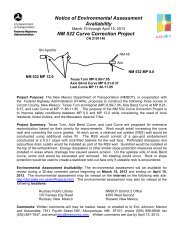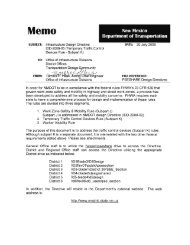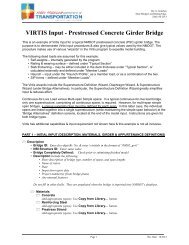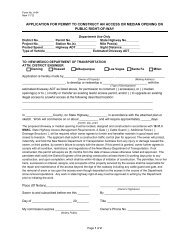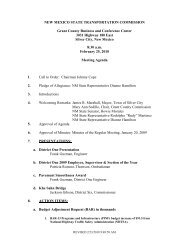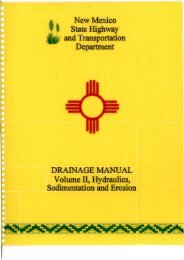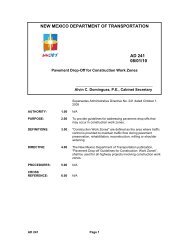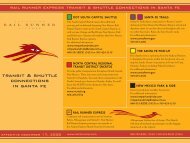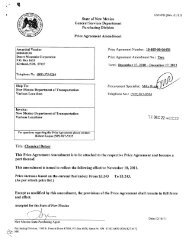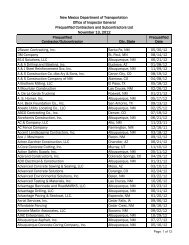Sampling of Aggregates AASHTO T-2-91 - New Mexico Department ...
Sampling of Aggregates AASHTO T-2-91 - New Mexico Department ...
Sampling of Aggregates AASHTO T-2-91 - New Mexico Department ...
You also want an ePaper? Increase the reach of your titles
YUMPU automatically turns print PDFs into web optimized ePapers that Google loves.
Aggregate T-2 January 2012<br />
<strong>Sampling</strong> <strong>of</strong> <strong>Aggregates</strong><br />
<strong>AASHTO</strong> T-2-<strong>91</strong> (2010)<br />
(Modified)<br />
Prior to performing any <strong>of</strong> the tests required for aggregate, it is necessary to obtain a sample.<br />
Samples can be obtained by a variety <strong>of</strong> methods. The preferred method is from a conveyor belt<br />
or bin discharge, and the third best is from the roadway. Windrow sampling is a distant fourth in<br />
order <strong>of</strong> preference, and stockpile sampling is the least preferred method, although relatively<br />
common. State guidelines will dictate point <strong>of</strong> acceptance.<br />
The most important consideration in sampling is to obtain a sample that represents the<br />
material to be tested. This can be greatly facilitated by combining several incremental samples<br />
selected using a systematic random sampling plan, by sampling the full cross-section at the<br />
sampling point where ever possible, by using methods which minimize segregation, and by<br />
avoiding obviously unrepresentative material.<br />
For NMDOT construction projects, the methods in <strong>AASHTO</strong> T-2 will apply primarily to base<br />
course and to aggregates for hot-mix asphalt (HMA), open-graded friction course (OGFC) and<br />
Portland cement concrete (PCC).<br />
Modification: 1. Windrow and Roadway samples require one increment.<br />
2. Windrow sampling is permitted and described.<br />
Key Elements:<br />
1. Select sample locations by random method.<br />
This requires use <strong>of</strong> random number table or<br />
random number generator applied<br />
systematically to the whole <strong>of</strong> material<br />
represented by sample to determine specific<br />
sampling points. Samples tested for quality<br />
shall be obtained from the finished product<br />
unless otherwise specified (4.1). Random<br />
sampling does not mean haphazard sampling.<br />
2. Combine sample mass to comply with<br />
Table 1, <strong>AASHTO</strong> T-2. This table provides<br />
minimum sample masses as a function <strong>of</strong> the<br />
maximum nominal aggregate size <strong>of</strong> the<br />
material. The values in the table apply to<br />
processed aggregates only. For combined<br />
materials (e.g. base course) <strong>AASHTO</strong><br />
recommends that the values in the table be<br />
increased by at least 10 kg (22 lb). In <strong>New</strong><br />
<strong>Mexico</strong>, this will be considered optional for<br />
<strong>New</strong> <strong>Mexico</strong> Technician Training and Certification Program<br />
<strong>AASHTO</strong> T-2 (2005 version – English / Metric Units)<br />
TABLE 1 – Size <strong>of</strong> Samples<br />
Approximate Minimum<br />
Maximum Nominal Size Mass <strong>of</strong> Field Samples,<br />
<strong>of</strong> <strong>Aggregates</strong> A lb (kg) B<br />
Fine Aggregate<br />
No. 8 (2.36 mm) 25 (10)<br />
No. 4 (4.75 mm) 25 (10)<br />
Coarse Aggregate<br />
3/8 in. (9.5 mm) 25 (10)<br />
½ in. (12.5 mm) 35 (15)<br />
<strong>AASHTO</strong> T-2 (2005 version – English /Metric Units)<br />
¾ in. (19.0 mm) 55 (25)<br />
1 in. (25.0 mm) 110 (50)<br />
1 ½ in. (37.5 mm) 165 (75)<br />
2 in. (50 mm) 220 (100)<br />
2 ½ in. (63 mm) 275 (125)<br />
3 in. (75 mm) 330 (180)<br />
3 ½ in. (80 mm) 385 (175)<br />
A<br />
For processed aggregate the nominal maximum size <strong>of</strong> particles is the largest sieve<br />
size listed in the applicable specification, upon which any material is permitted to be<br />
retained.<br />
B<br />
For combined coarse and fine aggregates (for example, base or subbase) minimum<br />
weight shall be coarse aggregate minimum plus 25 lb (10 kg).<br />
practical reasons, except when sample is a referee sample. This is a minor deviation from<br />
<strong>AASHTO</strong>. The values are minimum masses to ensure a reasonably representative sample.<br />
Larger samples should be obtained if necessary for tests to be performed (e.g. mix designs).
Aggregate T-2 January 2012<br />
3. Obtain increments as required. The increments combined shall meet or exceed the<br />
minimum mass described in No. 2 above. Again, locations for incremental samples should<br />
be determined using random number methodology. Windrow and Roadway samples<br />
require one (1) increment each. Flowing Stream/Bin, Conveyor Belt, and Stockpile<br />
samples require three (3) increments each.<br />
4. Place sample in suitable container. Transport container shall be constructed to prevent<br />
contamination, loss <strong>of</strong> material, loss <strong>of</strong> moisture, and contain fines or dust and prevent<br />
damage to contents from mishandling during shipment. Cloth bags are commonly used for<br />
aggregate. For material containing significant quantities for fines or dust, an alternate<br />
container such as a can or box may be more appropriate, in order to minimize loss <strong>of</strong><br />
material.<br />
5. Label sample properly. Minimum information shall include project I.D., name <strong>of</strong> sampler,<br />
sample location, date sampled, description <strong>of</strong> material and purpose <strong>of</strong> sample (tests<br />
required). Labels shall not smudge or run when wet and be affixed to the container in a way<br />
that it will not become detached or lost.<br />
Methods:<br />
A. Flowing Aggregate Stream (Belt or Bin Discharge): (4.3.1)<br />
1. Sample entire cross-section <strong>of</strong> discharge. It will probably be necessary to use a<br />
sampling box or a pan on rails beneath the discharge to intercept the flowing aggregate<br />
stream. Never attempt to intercept the stream with a shovel or a scoop, as this can cause<br />
serious injury. Obtain three approximately equal increments.<br />
2. Avoid sampling the initial discharge or final few tons <strong>of</strong> aggregates (Note 3).<br />
<strong>Sampling</strong> the initial and/or the final portion <strong>of</strong> material increases the chances <strong>of</strong><br />
obtaining a segregated sample. Additionally, bins should be kept as full as possible<br />
during the process to minimize segregation.<br />
B. Conveyor Belt: (4.3.2)<br />
1. Stop Conveyor. This is necessary for safety as well as for proper sampling technique.<br />
2. Insert a template conforming to the shape <strong>of</strong> the conveyor belt. A template shall be<br />
inserted perpendicular to the belt at a spacing that yields the desired increment <strong>of</strong><br />
material. Three increments are required to meet the mass in Table 1.<br />
3. Collect all material inside the template. Avoid spilling any material and collect all<br />
fines with a scoop, shovel, dustpan, and brush into a suitable container.<br />
C. Roadway: (4.3.4)<br />
1. Use template to mark area to be sampled. Obtain one sample, at a random location,<br />
which totals the minimum mass in Table 1.<br />
2. Sample the full depth <strong>of</strong> the material. This helps ensure representative material with<br />
minimal segregation.<br />
3. Avoid contaminating sample with underlying material.<br />
<strong>New</strong> <strong>Mexico</strong> Technician Training and Certification Program
Aggregate T-2 January 2012<br />
D. Windrow (not specifically described in <strong>AASHTO</strong> T-2):<br />
1. Avoid windrow sampling unless no alternative exists. There is a strong potential for<br />
obtaining a segregated sample from a windrow. However, circumstances may arise or<br />
specifications may dictate that this method be used. An example would be certain base<br />
course gradation samples where material has been sweetened and reprocessed on the<br />
roadway due to a previous out-<strong>of</strong>-specification test.<br />
2. Remove outer layer <strong>of</strong> material at sampling points. Material on the outside <strong>of</strong> the<br />
windrow is more likely to be segregated. Boards shall be driven into windrow around<br />
sampling location to prevent adjacent material from sloughing into area cleared <strong>of</strong><br />
surface material.<br />
3. Sample the full height <strong>of</strong> the remaining material. Material collected for the sample<br />
shall be obtained from the full height <strong>of</strong> the exposed face, after clearing the surface<br />
material.<br />
4. Obtain one (1) sample <strong>of</strong> sufficient size.<br />
E. Stockpile: (4.3.3)<br />
1. Avoid sampling stockpiles, if an alternative exists. It is difficult to obtain unbiased<br />
samples from stockpiles due to segregation (X1.2.1) that occurs when material is<br />
stockpiled, with coarser material rolling to the outside base <strong>of</strong> the stockpile.<br />
2. Develop smaller sampling pile from large pile using power equipment. Obtain<br />
increments from various levels <strong>of</strong> pile, and combine to form sampling pile (X1.2.1). For<br />
extremely large piles and where practical, consider development <strong>of</strong> a random sampling<br />
plan to create sampling stockpile.<br />
3. Sample from bottom third, middle third and top third by volume. Combine to form<br />
the minimum sample size from Table 1 (X1.2.2). Obtain at least three increments.<br />
4. Avoid sampling the outer layer <strong>of</strong> the pile or obviously segregated material. A board<br />
driven into the stockpile above the sampling point will help prevent further segregation<br />
(X1.2.2).<br />
Definition to Remember:<br />
Table 1, Note A<br />
Maximum Nominal Aggregate Size:<br />
For processed aggregate, the maximum nominal size <strong>of</strong> particles is the largest sieve size listed in<br />
the applicable specifications upon which any material is permitted to be retained.<br />
<strong>New</strong> <strong>Mexico</strong> Technician Training and Certification Program



